Chapter: Computer Networks
Transport layer
TRANSPORT LAYER
1. DATA COMPRESSION
┬Ę
Multimedia data, comprising audio, video, and still
images, now makes up the majority of traffic on the Internet by many estimates.
This is a
relatively recent developmentŌĆöit may be hard to believe now, but there was no
YouTube before 2005.
┬Ę
Part of what has made the widespread transmission
of multimedia across networks possible is advances in compression technology.
┬Ę
Because multimedia data is consumed mostly by
humans using their sensesŌĆövision and hearingŌĆöand processed by the human brain,
there are unique challenges to compressing it.
┬Ę
You want to try to keep the information that is
most important to a human, while getting rid of anything that doesnŌĆÖt improve
the humanŌĆÖs perception of the visual or auditory experience.
┬Ę
Hence, both computer science and the study of human
perception come into play.
┬Ę
In this section weŌĆÖll look at some of the major
efforts in representing and compressing multimedia data.
┬Ę
To get a sense of how important compression has
been to the spread of networked multimedia, consider the following example.
┬Ę
A high-definition TV screen has something like 1080
├Ś 1920 pixels, each of which has 24 bits of color information, so each frame is
1080 ├Ś 1920 ├Ś 24 = 50Mb and so if you want to send 24 frames per second, that
would be over 1Gbps.
┬Ę
ThatŌĆÖs a lot more than most Internet users can get
access to, by a good margin.
┬Ę
By contrast, modern compression techniques can get
a reasonably high quality HDTV signal down to the range of 10 Mbps, a two order
of magnitude reduction, and well within the reach of many broadband users.
┬Ę
Similar compression gains apply to lower quality
video such as YouTube clipsŌĆöweb video could never have reached its current
popularity without compression to make all those entertaining videos fit within
the bandwidth of todayŌĆÖs networks.
┬Ę
Lossless Compression Techniques
In many
ways, compression is inseparable from data encoding.
That is, in thinking about how to encode a piece of
data in a set of bits, we might just as well think about how to encode the data
in the smallest set of bits possible.
For example, if you have a block of data that is
made up of the 26 symbols A through Z, and if all of these symbols have an
equal chance of occurring in the data block you are encoding, then encoding
each symbol in 5 bits is the best you can do (since 25 = 32 is the
lowest power of 2 above 26).
If, however, the symbol R occurs 50% of the time,
then it would be a good idea to use fewer bits to encode the R than any of the
other symbols.
┬Ę
In general, if you know the relative probability
that each symbol will occur in the data, then you can assign a different number
of bits to each possible symbol in a way that minimizes the number of bits it
takes to encode a given block of data.
┬Ę
This is the essential idea of Huffman codes, one of
the important early developments in data compression.
1.1 Lossless
Compression Techniques
┬Ę
Run length Encoding
o
Run length encoding (RLE) is a compression
technique with a brute-force simplicity.
o
The idea is to replace consecutive occurrences of a
given symbol with only one copy of the symbol, plus a count of how many times
that symbol occursŌĆöhence the name ŌĆ£run length.ŌĆØ
o
For example, the string AAABBCDDDD would be encoded
as 3A2B1C4D.
1.2 Differential Pulse Code Modulation
o
Another simple lossless compression algorithm is
Differential Pulse Code Modulation (DPCM).
o
The idea here is to first output a reference symbol
and then, for each symbol in the data, to output the difference between that
symbol and the reference symbol.
o
For example, using symbol A as the reference
symbol, the string AAABBCDDDD would be encoded as A0001123333 since A is the
same as the reference symbol, B has a difference of 1 from the reference
symbol, and so on.
o
Dictionary based Methods
o
The final lossless compression method we consider
is the dictionary-based approach, of which the Lempel-Ziv (LZ) compression
algorithm is the best known.
o
The Unix compress and gzip commands use variants of
the LZ algorithm.
o
The idea of a dictionary-based compression
algorithm is to build a dictionary (table) of variable-length strings (think of
them as common phrases) that you expect to find in the data, and then to
replace each of these strings when it appears in the data with the
corresponding index to the dictionary.
o
Dictionary based Methods
o
For example, instead of working with individual
characters in text data, you could treat each word as a string and output the
index in the dictionary for that word.
o
To further elaborate on this example, the word
ŌĆ£compressionŌĆØ has the index 4978 in one particular dictionary; it is the 4978th
word in /usr/share/dict/words.
o
To compress a body of text, each time the string
ŌĆ£compressionŌĆØ appears, it would be replaced by 4978.
1.2 Image Representation and Compression
Given the
increase in the use of digital imagery in recent yearsŌĆöthis use was spawned by
the invention of graphical displays, not high-speed networksŌĆöthe need for
standard representation formats and compression algorithms for digital imagery
data has grown more and more critical.
In
response to this need, the ISO defined a digital image format known as JPEG, named
after the Joint Photographic Experts Group that designed it. (The ŌĆ£JointŌĆØ in
JPEG stands for a joint ISO/ITU effort.)
1.3 Image Representation and Compression
o
JPEG is the most widely used format for still
images in use today.
o
At the heart of the definition of the format is a
compression algorithm, which we describe below.
o
Many techniques used in JPEG also appear in MPEG,
the set of standards for video compression and transmission created by the
Moving Picture Experts Group.
o
Digital images are made up of pixels (hence the
megapixels quoted in digital camera advertisements).
o
Each pixel represents one location in the
two-dimensional grid that makes up the image, and for color images, each pixel
has some numerical value representing a color.
o
There are lots of ways to represent colors,
referred to as color spaces: the one most people are familiar with is RGB (red,
green, blue).
2.
INTRODUCTION TO JPEG

2.1 JPEG Compression
DCT Phase
DCT is a
transformation closely related to the fast Fourier transform (FFT). It takes an
8 ├Ś 8
matrix of pixel values as input and outputs an 8 ├Ś 8 matrix of frequency
coefficients.
You can
think of the input matrix as a 64-point signal that is defined in two spatial
dimensions (x and y); DCT breaks this signal into 64 spatial frequencies. DCT,
along with its inverse, which is performed during decompression, is defined by
the following formulas:
where
pixel(x, y) is the grayscale value of the pixel at position (x, y) in the 8├Ś8
block being compressed; N = 8 in this case
Quantization
Phase
The
second phase of JPEG is where the compression becomes lossy.
DCT does
not itself lose information; it just transforms the image into a form that
makes it easier to know what information to remove.
Quantization
is easy to understandŌĆöitŌĆÖs simply a matter of dropping the insignificant bits
of the frequency coefficients
Quantization Phase
n The basic quantization equation
is QuantizedValue(i, j) = IntegerRound(DCT(i, j)/Quantum(i, j)) Where
n Decompression is then simply
defined as DCT(i, j) = QuantizedValue(i, j) ├Ś Quantum(i, j)
Encoding
Phase
┬¦ The final
phase of JPEG encodes the quantized frequency coefficients in a compact form.
┬¦ This
results in additional compression, but this compression is lossless.
┬¦ Starting
with the DC coefficient in position (0,0), the coefficients are processed in
the zigzag sequence.
┬¦ Along
this zigzag, a form of run length encoding is usedŌĆöRLE is applied to only the 0
coefficients, which is significant because many of the later coefficients are
0.
┬¦ The
individual coefficient values are then encoded using a Huffman code.
3. INTRODUCTION TO MPEG
3.1Video Compression (MPEG)
We now turn our attention to the MPEG format,
named after the Moving Picture Experts Group that defined it.
To a
first approximation, a moving picture (i.e., video) is simply a succession of
still imagesŌĆöalso called frames or picturesŌĆödisplayed at some video rate.
Each of
these frames can be compressed using the same DCT-based technique used in JPEG
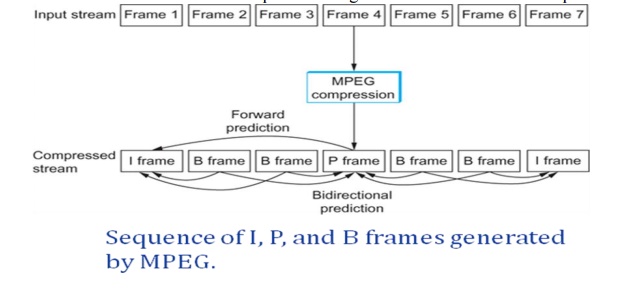
3.2 Frame Types
MPEG
takes a sequence of video frames as input and compresses them into three types
of frames, called I frames (intrapicture), P frames (predicted picture), and B
frames (bidirectional predicted picture).
Each
frame of input is compressed into one of these three frame types. I frames can
be thought of as reference frames; they are self-contained, depending on
neither earlier frames nor later frames.
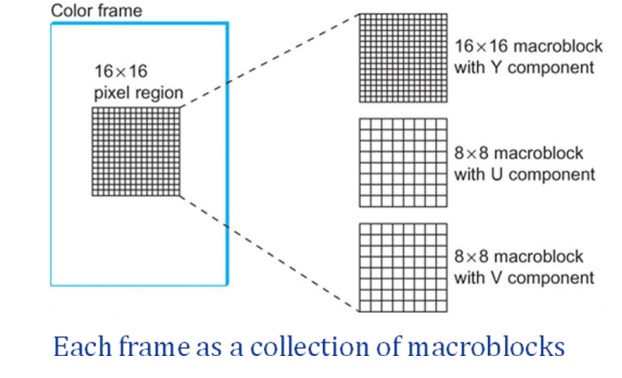
4. INTRODUCTION TO MP3
The most
common compression technique used to create CD-quality audio is based on the
perceptual encoding technique. This type of audio needs at least 1.411 Mbps,
which cannot be sent over the Internet without compression. MP3 (MPEG audio
layer 3) uses this technique.
The basic
perceptual model used in MP3 is that louder frequencies mask out adjacent
quieter ones. People can not hear a quiet sound at one frequency if there is a
loud sound at another
This can
be explained better by the following figures presented by Rapha Depke
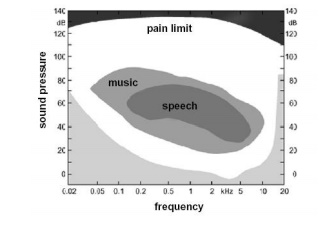
The audio
signal passes through 32 filters with different frequency
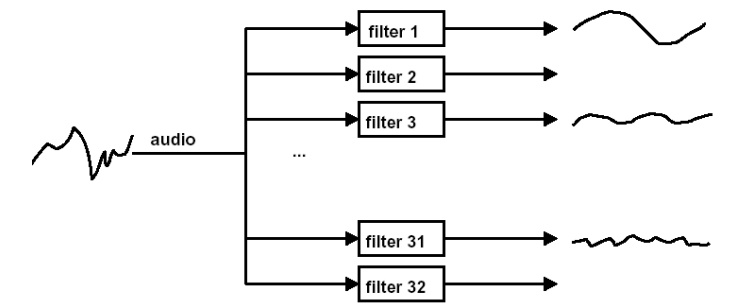
Joint stereo coding takes advantage of the fact that both channels of a
stereo channel pair contain similar information
These
stereophonic irrelevancies and redundancies are exploited to reduce the total
bitrate
Joint
stereo is used in cases where only low bitrates are available but stereo
signals are desired.
Encoder
A typical
solution has two nested iteration loops
Distortion/Noise control loop (outer loop)
Rate control loop (inner loop)
ŌĆó
Rate control loop
┬Ę
For a given bit rate allocation, adjust the
quantization steps to achieve the bit rate.
This loop checks if the number of bits resulting
from the coding operation exceeds the number of bits available to code a given
block of data.
If it is true, then the quantization step is
increased to reduce the total bits. This can be achieved by adjusting the
global gain
5. CRYPTOGRAPHY
What Is Cryptography
Cryptography
is the science of hiding information in plain sight, in order to conceal it
from unauthorized parties.
Substitution
cipher first used by Caesar for battlefield communications
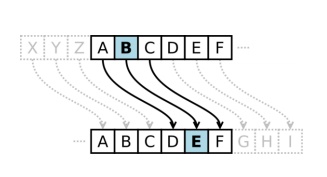
Encryption Terms and Operations
Plaintext
ŌĆō an original message
Ciphertext
ŌĆō an encrypted message
Encryption
ŌĆō the process of transforming plaintext into ciphertext (also encipher)
Decryption
ŌĆō the process of transforming ciphertext into plaintext (also decipher)
Encryption key ŌĆō the text value required to
encrypt and decrypt data
Encryption methodologies
Substitution Cipher
Plaintext characters are substituted to form
ciphertext
ŌĆ£AŌĆØ becomes ŌĆ£RŌĆØ, ŌĆ£BŌĆØ becomes ŌĆ£GŌĆØ, etc.
Character rotation
Caesar rotated three to the right (A > D,
B > E, C > F, etc.)
A table or formula is used
ROT13 is a Caesar cipher
Image from Wikipedia (link Ch 5a)
Subject to frequency analysis attack
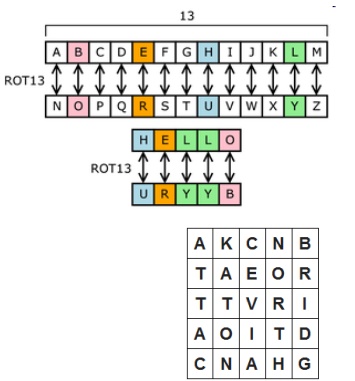
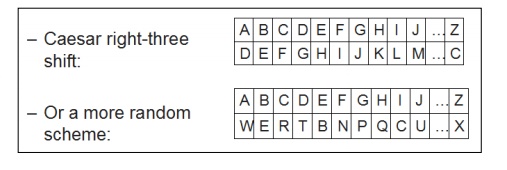
5.1
Transposition Cipher
Plaintext messages are transposed into
ciphertext
Plaintext: ATTACK AT ONCE VIA NORTH BRIDGE
Write into columns going down
Read from columns to the right Ciphertext:
AKCNBTAEORTTVRIAOITDCNAHG Subject to
frequency analysis attack Monoalphabetic Cipher
One alphabetic character is substituted or
another
Subject to frequency analysis attack
5.2 Polyalphabetic Cipher
Two or more substitution alphabets
CAGED becomes RRADB
Not subject to frequency attack
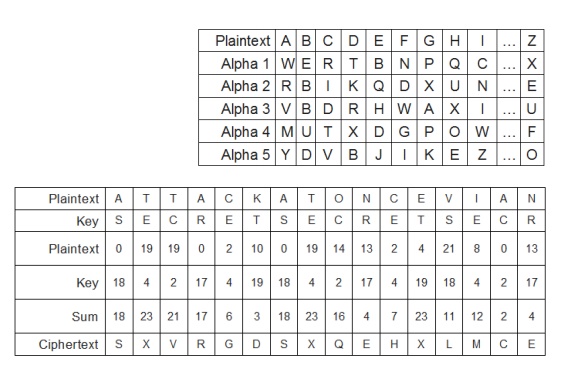
Running-key Cipher Plaintext letters
converted to numeric (A=0, B=1, etc.)
Plaintext values ŌĆ£addedŌĆØ to key values
giving ciphertext
Modulo arithmetic is used to keep results in
range 0-26

Add 26 if results < 0; subtract 26 if
results > 26 One-time Pad
Works like running key cipher, except that
key is length of plaintext, and is used only once
Highly resistant to cryptanalysis
5.3
Types of ecryption
Block cipher
Encrypts blocks of data, often 128 bits
Stream cipher
Operates on a continuous stream of data
Block Ciphers
Encrypt and decrypt a block of data at a
time Typically 128 bits
Typical uses for block ciphers
Files, e-mail messages, text communications,
web Well known encryption algorithms
DES, 3DES, AES, CAST, Twofish, Blowfish,
Serpent
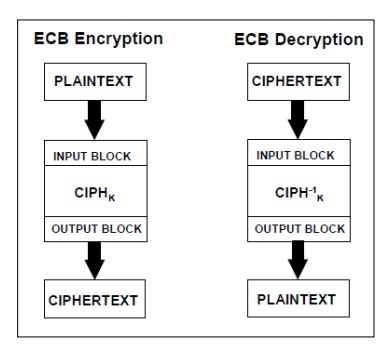
Block Cipher Modes of Operation
Electronic Code Book (ECB)
Cipher-block chaining (CBC)
Cipher feedback (CFB)
Output feedback (OFB)
Counter
(CTR)
5.4 Initialization Vector (IV)
Starting
block of information needed to encrypt the first block of data IV must be
random and should not be re-used
WEP wireless encryption is weak because it re-uses
the IV, in addition to making other errors
Block Cipher: Cipher-block Chaining (CBC)
Ciphertext output from each encrypted
plaintext block is used in the encryption for the next block
First block encrypted with IV (initialization
vector)
Block Cipher: Cipher Feedback (CFB)
Plaintext for block N is XORŌĆÖd with the
ciphertext from block N-1. In the first block, the plaintext XORŌĆÖd with the
encrypted IV
5.5 Stream Ciphers
Used to
encrypt a continuous stream of data, such as an audio or video transmission
A stream cipher is a substitution cipher that
typically uses an exclusive-or (XOR) operation that can be performed very
quickly by a computer.
Most common stream cipher is RC4 Other stream ciphers
5.6 Types of Encryption Keys Symmetric key
A common
secret that all parties must know
Difficult
to distribute key securely
Used by
DES, 3DES, AES, Twofish, Blowfish, IDEA, RC5
Asymmetric key
Public /
private key
Openly
distribute public key to all parties
Keep
private key secret
Anyone
can use your public key to send you a message
Used by
RSA. El Gamal, Elliptic Curve
Asymmetric
Encryption Uses
Encrypt
message with recipient's public key
Only
recipient can read it, using his or her private key Provides confidentiality
Sign message
Hash
message, encrypt hash with your private key Anyone can verify the signature
using your public key
Provides
integrity and non-repudiation (sender cannot deny authorship) Sign and encrypt
Both of
the above
6. SYMMETRIC KEY
┬Ę
most symmetric block ciphers are based on a Feistel
Cipher Structure
┬Ę
needed since must be able to decrypt ciphertext to
recover messages efficiently
┬Ę
block ciphers look like an extremely large
substitution
┬Ę
would need table of 264 entries for a
64-bit block
┬Ę
instead create from smaller building blocks
┬Ę
using idea of a product cipher
┬Ę
Horst Feistel devised the feistel cipher
based on concept of invertible product cipher
┬Ę
partitions input block into two halves
process through multiple rounds which
perform a substitution on left data half
based on round function of right half & subkey
then have permutation swapping halves
┬Ę
implements ShannonŌĆÖs substitution-permutation
network concept
┬Ę
block size
increasing size improves security, but slows cipher
┬Ę
key size
increasing size improves security, makes exhaustive
key searching harder, but may slow cipher
┬Ę
number of rounds
increasing number improves security, but slows
cipher
┬Ę
subkey generation
greater complexity can make analysis harder, but
slows cipher
┬Ę
round function
greater complexity can make analysis harder, but
slows cipher
┬Ę
fast software en/decryption & ease of analysis
are more recent concerns for practical use and
testing
7. PUBLIC-KEY
Rapidly
increasing needs for flexible and secure transmission of information require to
use new cryptographic methods.
The main
disadvantage of the classical cryptography is the need to send a (long) key
through a super secure channel before sending the message itself.
In
secret-key (symetric key) cryptography both sender and receiver share the same
secret
key.
In public-key ryptography there are two different
keys: a public encryption key
and
a secret
decryption key (at the receiver side).
Basic
idea: If it is infeasible from the knowledge of an encryption algorithm ek
to construct the corresponding description algorithm dk, then ek
can be made public.
Toy
example: (Telephone directory encryption)
Start:
Each user U makes public a unique telephone directory tdU to encrypt
messages for U and U is the only user to have an inverse telephone directory
itdU.
Encryption:
Each letter X of a plaintext w is replaced, using the telephone directory tdU
of the intended receiver U, by the telephone number of a person whose name
starts with letter X.
Decryption:
easy for Uk, with an inverse telephone directory, infeasible for
others. Analogy:
Secret-key
cryptography 1. Put the message into a box, lock it with a padlock and send the
box. 2. Send the key by a secure channel.
Public-key
cryptography Open padlocks, for each user different one, are freely available.
Only legitimate user has key from his padlocks. Transmission: Put the message
into the box of the intended receiver, close the padlock
Main
problem of the secret-key cryptography: a need to make a secure distribution
(establishment) of secret keys ahead of transmissions.
Diffie+Hellman
solved this problem in 1976 by designing a protocol for secure key
establishment (distribution) over public channels.
Protocol:
If two parties, Alice and Bob, want to create a common secret key, then they
first agree, somehow, on a large prime p and a primitive root q (mod p) and
then
they
perform, through a public channel, the following activities.
Alice
chooses, randomly, a large 1 Ł x < p -1 and computes X = q x mod
p.
Bob also
chooses, again randomly, a large 1 Ł y < p -1 and computes Y = q y
mod p.
Alice and
Bob exchange X and Y, through a public channel, but keep x, y secret.
Alice
computes Y x mod p and Bob computes X y mod p and then
each of them has the
Key K = q xy mod p.
The
following attack by a man-in-the-middle is possible against the Diffie-Hellman
key establishment protocol.
. Eve
chooses an exponent z.
Eve sends
q z to both Alice and Bob. (After that Alice believes she has
received q x and Bob believes he has received q y.)
Eve
intercepts q x and q y.
When
Alice sends a message to Bob, encrypted with KA, Eve intercepts it,
decrypts it,
then encrypts it with KB and sends it to Bob without any need
forsecret key distribution (Shamir's no-key algorithm)
Basic assumption: Each user X has its own
secret
encryption function eX secret decryption function dX
and all
these functions commute (to form a commutative cryptosystem). Communication
protocol
with
which Alice can send a message w to Bob.
Alice sends eA (w) to Bob
Bob sends eB (eA (w)) to
Alice
Alice sends dA (eB (eA
(w))) = eB (w) to Bob
Bob performs the decryption to get dB (eB
(w)) = w.
8. AUTHENTICATION
┬Ę
fundamental security building block
basis of
access control & user accountability
┬Ę
is the process of verifying an identity claimed by
or for a system entity
┬Ę
has two steps:
identification
- specify identifier
verification
- bind entity (person) and identifier
distinct
from message authentication
four
means of authenticating user's identity
based one
something the individual
┬Ę
knows - e.g. password, PIN
┬Ę
possesses - e.g. key, token, smartcard
┬Ę
is (static biometrics) - e.g. fingerprint, retina
┬Ę
does (dynamic biometrics) - e.g. voice, sign
can use
alone or combined
all can
provide user authentication all have issues
Authentication Protocols
used to
convince parties of each others identity and to exchange session keys
may be
one-way or mutual
key
issues are
┬Ę
confidentiality ŌĆō to protect session keys
┬Ę
timeliness ŌĆō to prevent replay attacks
where a
valid signed message is copied and later resent
┬Ę
simple replay
┬Ę
repetition that can be logged
┬Ę
repetition that cannot be detected
┬Ę
backward replay without modification
countermeasures
include
┬Ę
use of sequence numbers (generally impractical)
┬Ę
timestamps (needs synchronized clocks)
┬Ę
challenge/response (using unique nonce)
One-Way Authentication
┬Ę
required when sender & receiver are not in
communications at same time (eg. email)
┬Ę
have header in clear so can be delivered by email
system
┬Ę
may want contents of body protected & sender
authenticated
┬Ę
as discussed previously can use a two-level
hierarchy of keys
┬Ę
usually with a trusted Key Distribution Center
(KDC)
each
party shares own master key with KDC
KDC
generates session keys used for connections between parties
master
keys used to distribute these to them
9. KEY DISTRIBUTION
ŌĆó In
designing the key distribution protocol, the authors took into consideration
the following requirements:
ŌĆó Security
domain change: The Certifiction Authority (CA) of the receiving security domain must be able to
authenticate the agent which comes from another security domain.
ŌĆó Trust establishment:
The key distribution process should start with a very high trust relationship with the
Certifiction Authority (CA) .
ŌĆó Secure
key distribution: The key distribution process should be conducted in a secure manner (e.g., trusted path).
ŌĆó Efficiency:
The key distribution process should not consume a lot of resources, such as machines CPUs and network
bandwidth.
ŌĆó Scalability:
The key distribution process must be scalable enough, so that the mobile agent can have the ability to
roam widely.
ŌĆó Transparency:
The mobile agents should not include a code which is proper to key distribution.
ŌĆó This will
ease programming as agents programmers will concentrate on the programming logic rather than the
key obtaining issues.
ŌĆó Portability:
The protocol should not be platform specific and should be ported to any mobile agent platform.
ŌĆó Ease of
administration: The key distribution protocol should not be a burden on the administrator. The protocol is an
automated infrastructure that should require minimum administratorŌĆÖs
intervention.
9.1 Key Distribution Mechanisms.
System Components:
A key
distribution system for mobile agents includes the following components:
Agent: An
agent is a software component which executes on behalf of a particular user who
is the user of the agent.
An agent can be mobile and move from one host server to another under
its own control to achieve tasks on these hosts servers.
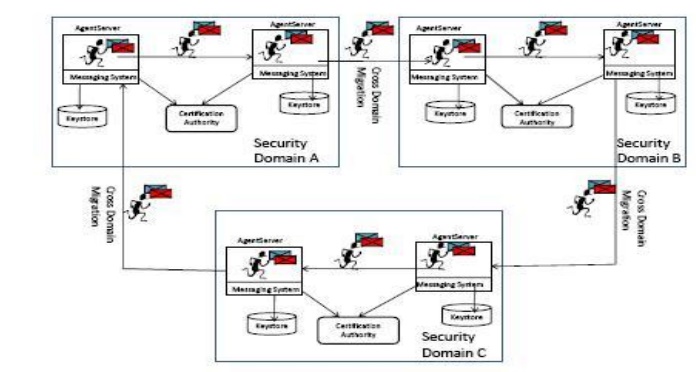
┬Ę
Agent Server: Each host, as part of the mobile
agent platform, runs an execution environment, the agent server.
┬Ę
Messaging System. A messaging system is part of an
agent execution environment. It provides facilities for agents to communicate
both locally and remotely
┬Ę
The CA. It is a trusted third party which provides
digital certificates for mobile agents, users and agent servers.
All digital certificates are signed by the CA for further verification
of their authenticity and validity.
┬Ę
Keystore: Each agent server has a local database
which is used to store and retrieve its own private/public key pair and the
digital certificate.
┬Ę
It also stores the digital certificate of the
trusted CA and other agent severs, mobile agents, and CAs with which the agent
server has prior communication.
┬Ę
Similarly, each CA has a local keystore .
┬Ę
Security Domain: A security domain consists of a
group of agent servers which are under one common CA. In the security domain,
the agent servers have the digital certificate of their local CA stored in
their local keystores.
┬Ę
When a mobile agent moves, it can move within the
same security domain or changes a security domain.
10. KEY
AGREEMENT
ŌĆō Flexibility in credentials
ŌĆō Modern, publically analysed/available
cryptographic primitives
ŌĆō Freshness guarantees
ŌĆō PFS?
ŌĆō Mutual authentication
ŌĆō Identity hiding for supplicant/end-user
ŌĆō No key re-use
ŌĆō Fast re-key
ŌĆō Fast handoff
ŌĆō Efficiency not an overarching concern:
┬Ę
Protocol runs only 1/2^N-1 packets, on average
ŌĆō DOS resistance
Credentials flexibility
Local
security policy dictates types of credentials used by end-users
Legacy
authentication compatibility extremely important in market
┬Ę Examples:
ŌĆō username/password
ŌĆō Tokens (SecurID, etc)
ŌĆō X.509 certificates
Algorithms
┬Ę Algorithms
must provide confidentiality and integrity of the authentication and key
agreement.
┬Ę Public-key
encryption/signature
ŌĆō RSA
ŌĆō ECC
ŌĆō DSA
┬Ę PFS
support D-H
┬Ę Most
cryptographic primitives require strong random material that is ŌĆ£freshŌĆØ.
ŌĆō Not a protocol issue, per se, but a design
requirement nonetheless
┬Ę Both
sides of authentication/key agreement must be certain of identity of other
party.
┬Ę Symmetric
RSA/DSA schemes (public-keys on both sides)
┬Ę Asymmetric
schemes
ŌĆō Legacy on end-user side
ŌĆō RSA/DSA on authenticator side
11. PGP
PGP
provides a confidentiality and authentication service that can be used for file
storage and electronic mail applications.
PGP was
developed be Phil Zimmermann in 1991 and since then it has grown in popularity.
There have been several updates to PGP.
A free
versions of PGP is available over the Internet, but only for non-commercial
use. The latest (Jan. 2000) current version is 6.5.
Commercial
versions of PGP are available from the PGP Division of Network Associates
For three
years, Philip Zimmermann, was threatened with federal prosecution in the United
States for his actions. Charges were finally dropped in January 1996.
At the
close of 1999, Network Associates, Inc. announced that it has been granted a
full license by the U.S. Government to export PGP world-wide, ending a
decades-old ban.
PGP
enables you to make your own public and secret key pairs.
PGP public keys are distributed and certified via an informal network
called "the web of trust".
Most experts consider PGP very secure if used
correctly. PGP is based on RSA, DSS, Diffie-Hellman in the public encryption
side, and CAST.128, IDEA, 3DES for conventional encryption. Hash coding is done
with SHA-1.
PGP has a wide range of applicability from
corprorations that wish to enforce a standardized scheme for encryptin files
and messages to individuals who wish to communicate securely with each others
over the interent.
The actual operation of PGP consists of five
services: authentication, confidentiality, compression, e-mail compatibility
and segmentation (Table 12.1.)
Authenticaiton
The digital signature service is illustrated in Fig
12.1a.
ŌĆō EC is used for conventional encryption, DC for
decryption, and EP and ED correspondingly for public key encryption and
decryption.
The algorithms used are SHA-1 and RSA.
Alternatively digital signatures can be generated using DSS/SHA-1.
Normally digital signatures are attached to the
files they sign, but there are exceptions
ŌĆō a detached signature can be used to detect a
virus infection of an executable program.
ŌĆō sometimes more than one party must sign the
document.
a
separate signature log of all messages is maintained
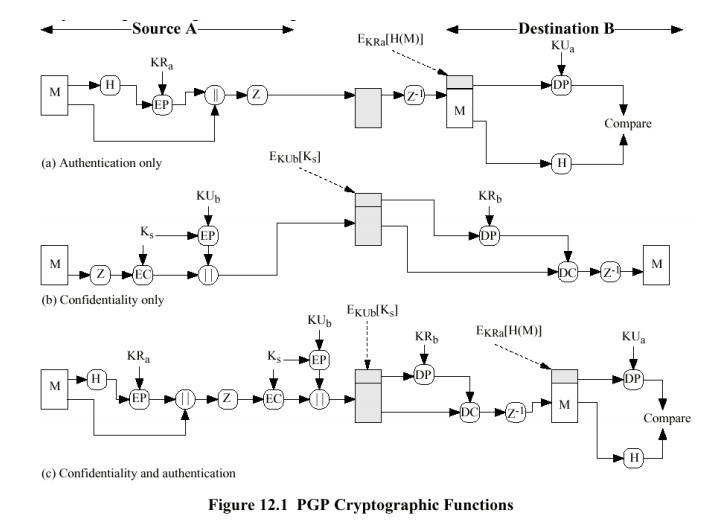
Confidentiality
ŌĆó Confidentiality service is
illustrated in Fig 12.1b.
┬Ę
Confidentiality can be use for storing files
locally or transmitting them over insecure channel.
┬Ę
The algorithms used are CAST-128 or alternatively
IDEA or 3DES. The ciphers run in CFB mode.
┬Ę
Each conventional key is used only once.
ŌĆō A new key is generated as a random 128-bit
number for each message.
ŌĆō The key is encrypted with the receivers public
key (RSA) and attached to the message.
ŌĆō An alternative to using RSA for key encryption,
ELGamal, a variant of Diffie-Hellman providing also encryption/decryption, can
be used.
┬Ę
The use of conventional encryption is fast compared
to encryption the whole message with RSA.
┬Ę
The use of public key algorithm solves the use
session key distribution problem. In email application any kind of handshaking would
not be practical.
12. SSH
protocol
for secure network communications
ŌĆō designed to be simple & inexpensive
SSH1
provided secure remote logon facility
ŌĆō replace TELNET & other insecure schemes
ŌĆō also has more general client/server
capability
Can be used for FTP, for example
SSH2 was
documented in RFCs 4250 through 4254
SSH clients & servers are widely available (even in OSs)
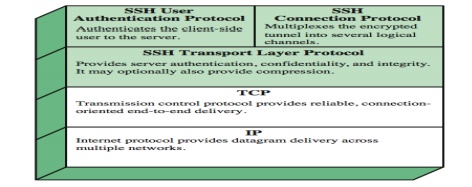
Identification
string exchange
ŌĆō To know which SSH version, which SSH
implementation
Algorithm
Negotitation
ŌĆō For the crypto algorithms (key exchange,
encryption, MAC) and compression algo.
ŌĆō A list in the order of preference of the
client
ŌĆō For each category, the algorithm chosen is the
first algorithm on the client's list that is also supported by the server.
key
exchange
ŌĆō Only two exchanges
ŌĆō Diffie-Hellman based
ŌĆō Also signed by the server (host private key)
ŌĆō As a result (i) two sides now share a master key
K. (ii) the server has been authenticated to the client.
┬Ę
Then, encryption, MAC keys and IV are derived from
the master key
┬Ę
End of key exchange
ŌĆō To signal the end of key exchange process
ŌĆō Encrypted and MACed using the new keys
┬Ę
Service Request: to initiate either user
authentication or connection protocol
┬Ę
Authentication of client to server
┬Ę
First client and server agree on an authentication
method
ŌĆō Then a sequence of exchanges to perform that
method
ŌĆō Several authentication methods may be
performed one after another
┬Ę
authentication methods
ŌĆō public-key
Client
signs a message and server verifies
ŌĆō password
Client
sends pasword which is encrypted and MACed using the keys agreed
ŌĆō runs on SSH Transport Layer Protocol
ŌĆō assumes secure authentication connection
ŌĆō which is called tunnel
ŌĆō used for multiple logical channels
ŌĆō SSH communications use separate channels
ŌĆō either side can open with unique id number
ŌĆō flow controlled via sliding window mechanism
ŌĆō have three stages:
ŌĆō opening a channel, data transfer, closing a
channel
13. TRANSPORT SECURITY
transport
layer security service
originally
developed by Netscape
version 3
designed with public input
subsequently
became Internet standard known as TLS (Transport Layer Security)
uses TCP
to provide a reliable end-to-end service
SSL has
two layers of protocols
SSL
connection
┬Ę
a transient, peer-to-peer, communications link
┬Ę
associated with 1 SSL session
SSL
session
┬Ę
an association between client & server
┬Ę
created by the Handshake Protocol
┬Ę
define a set of cryptographic parameters
┬Ę
may be shared by multiple SSL connections
confidentiality
using
symmetric encryption with a shared secret key defined by Handshake Protocol
AES,
IDEA, RC2-40, DES-40, DES, 3DES, Fortezza, RC4-40, RC4-128
message
is compressed before encryption
┬Ę
message integrity
using a
MAC with shared secret key
similar
to HMAC but with different padding
┬Ę
one of 3 SSL specific protocols which use the SSL
Record protocol
┬Ę
a single message
┬Ę
causes pending state to become current
┬Ę
hence updating the cipher suite in use
14. IP SECURITY
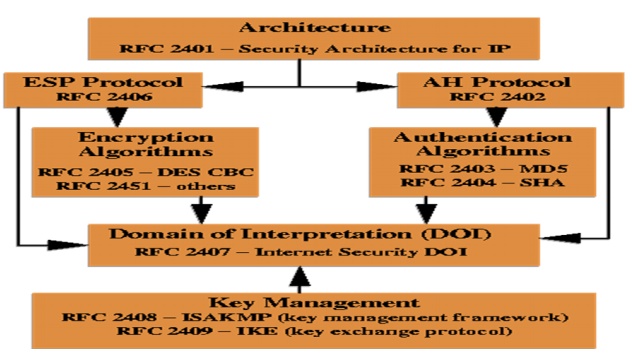
RFC
2401 - Overall security architecture and
services offered by IPSec.
Authentication
Protocols
┬Ę
RFC 2402 ŌĆō IP Authentication Header processing
(in/out bound packets )
┬Ę
RFC 2403 ŌĆō Use of MD-5 with Encapsulating Security
Payload and Authentication Header
┬Ę
RFC 2404 - Use of Sha1with Encapsulating Security
Payload and Authentication Header
ESP
Protocol
┬Ę
RFC 2405 ŌĆō Use of DES-CBS which is a symmetric
secret key block algorithm (block size 64 bits).
┬Ę
RFC 2406 ŌĆō IP Encapsulating Security Payload
processing (in/out bound packets)
RFC 2407
ŌĆō Determines how to use ISAKMP for IPSec
RFC 2408
(Internet Security Association and Key Management Protocol - ISAKMP)
┬Ę
Common frame work for exchanging key securely.
┬Ę
Defines format of Security Association (SA)
attributes, and for negotiating, modifying, and deleting SA.
┬Ę
Security Association contains information like
keys, source and destination address, algorithms used.
┬Ę
Key exchange mechanism independent.
RFC 2409
ŌĆō Internet key exchange
┬Ę
Mechanisms for generating and exchanging keys
securely.
┬Ę
Designed to provide both confidentiality and
integrity protection
┬Ę
Everything after the IP header is encrypted
┬Ę
The ESP header is inserted after the IP header
┬Ę
Designed for integrity only
┬Ę
Certain fields of the IP header and everything
after the IP header is protected
┬Ę
Provides protection to the immutable parts of the
IP header
┬¦
15. WIRELESS SECURITY
┬Ę
Wireless connections need to be secured since the
intruders should not be allowed to access, read and modify the network traffic.
┬Ę
Mobile systems should be connected at the same
time.
┬Ę
Algorithm is required which provides a high level
of security as provided by the physical wired networks.
┬Ę
Protect wireless communication from eavesdropping,
prevent unauthorized access.
┬Ę
Access Control
Ensure
that your wireless infrastructure is not used.
┬Ę
Data Integrity
Ensure
that your data packets are not modified in transit.
┬Ę
Confidentiality
Ensure
that contents of your wireless traffic is not leaked.
┬Ę
WEP relies on a secret key which is shared
between the sender (mobile station) and the receiver (access point).
┬Ę
Secret Key : packets are encrypted using the secret
key before they are transmitted.
┬Ę
Integrity Check : it is used to ensure that packets
are not modified in transit
┬Ę
To send a message to M:
Compute
the checksum c(M). Checksum does not depend on the secret key ŌĆśkŌĆÖ.
Pick a IV
ŌĆśvŌĆÖ and generate a key stream RC4(v,k).
XOR
<M,c(M)> with the key stream to get the cipher text.
Transmit
ŌĆśvŌĆÖ and the cipher text over a radio link.
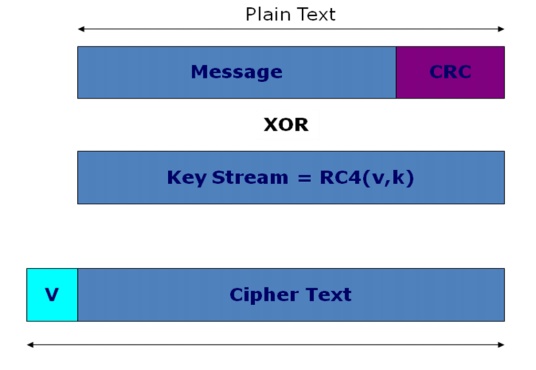
WEP uses
RC4 encryption algorithm known as ŌĆ£stream cipherŌĆØ to protect the
confidentiality of its data.
Stream
cipher operates by expanding a short key into an infinite pseudo-random key
stream.
Sender
XORŌĆÖs the key stream with plaintext to produce cipher text.
Receiver
has the copy of the same key, and uses it to generate an identical key stream.
XORing
the key stream with the cipher text yields the original message.
Passive
Attacks
To decrypt
the traffic based on statistical analysis (Statistical Attack)
Active
Attacks
To inject
new traffic from authorized mobile stations, based on known plaintext.
Active
Attacks
To
decrypt the traffic based on tricking the access point
Dictionary
Attacks
Allow
real time automated decryption of all traffic.
16. FIREWALLS
Effective
means of protection a local system or network of systems from network-based
security threats while affording access to the outside world via WAN`s or the
Internet
Information
systems undergo a steady evolution (from small LAN`s to Internet connectivity)
Strong
security features for all workstations and servers not established
The
firewall is inserted between the premises network and the Internet
Aims:
Establish
a controlled link
┬Ę
Protect the premises network from Internet-based
attacks
┬Ę
Provide a single choke point
Design
goals:
┬Ę
All traffic from inside to outside must pass
through the firewall (physically blocking all access to the local network
except via the firewall)
┬Ę
Only authorized traffic (defined by the local
security police) will be allowed to pass
Four general techniques:
Service
control
┬Ę
Determines the types of Internet services that can
be accessed, inbound or outbound
Direction
control
┬Ę
Determines the direction in which particular
service requests are allowed to flow
User
control
┬Ę
Controls access to a service according to which
user is attempting to access it
Behavior
control
┬Ę
Controls how particular services are used (e.g.
filter e-mail)
Types of Firewalls
Three common types of Firewalls:
ŌĆō Packet-filtering routers
ŌĆō Application-level gateways
ŌĆō Circuit-level gateways (Bastion host
Packet-filtering
Router

Packet-filtering Router
ŌĆō Applies a set of rules to each incoming IP packet
and then forwards or discards the packet
ŌĆō Filter packets going in both directions
ŌĆō The packet filter is typically set up as a list
of rules based on matches to fields in the IP or TCP header
ŌĆō Two default policies (discard or forward)
Advantages:
ŌĆō Simplicity
ŌĆō Transparency to users
ŌĆō High speed
Disadvantages:
ŌĆō Difficulty of setting up packet filter rules
ŌĆō Lack of Authentication
Related Topics